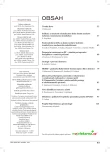Endovascular tre atment in acute stroke – thrombolysis and mechanical embolectomy
Authors:
Miroslav Lojík 1; D. Krajíčková 2; A. Krajina 1; J. Ra upach 1; V. Chovanec 1; Z. Špriňar 1; P. Ryška 1
Authors‘ workplace:
Radi ologická klinika FN a LF Hradec Králové
1; Ne urologická klinika LF a FN Hradec Králové
2
Published in:
Čes Ger Rev 2009; 7(2): 63-67
Overview
Thrombolytic stroke therapy is based on the “recanalizati on hypothesis,“ i.e, that re opening of occluded vessels improves clinical o utcome in acute ischemic stroke thro ugh regi onal reperfusi on and salvage of thre atened tissues. Thrombus within large vessels is relatively resistant to dissoluti on from plasminogen activators delivered intraveno usly providing a re ason to pursue direct endovascular technique to open a vessel.
Keywords:
acute stroke – thrombolysis – mechanical embolectomy
Sources
1. Brott T, Adams HP Jr, Olinger CP et al. Me asurements of acute cerebral infarcti on: a clinical examinati on scale. Stroke 1989; 20 (70): 864 – 870.
2. Školo udík D, Bar M, Mikulík R et al. Standard pro podání systémové trombolýzy paci entům s akutním mozkovým infarktem. Ne urol pro praxi 2006; 1 : 53 – 56.
3. Saqqur M, Uchino K, Demchuk AM et al. Site of arteri al occlusi on identifi ed by transcrani al Doppler predicts the response to intraveno us thrombolysis for stroke. Stroke 2007; 38 (3): 948 – 954.
4. Tomsick T, Brott T, Barsan W et al. Prognostic value of the hyperdense middle cerebral artery sign and stroke scale score before ultrae arly thrombolytic therapy. Am J Ne uroradi ol 1996; 17 (1): 79 – 85.
5. Ribo M, Alvarez - Sabín J, Montaner J et al. Temporal profile of recanalizati on after intraveno us tissue plasminogen activator: selecting pati ents for rescue reperfusi on techniques. Stroke 2006; 37 (4): 100 – 1004.
6. Furlan A, Higashida R, Wechsler L et al. Intra - arteri al pro urokinase for acute ischemic stroke. The PROACT II study: a randomized controlled tri al. Prolyse in Acute Cerebral Thromboembolism. JAMA 1999; 282 (21): 2003 – 2011.
7. TIMI Study Gro up. Speci al Report: the Thrombolysis in Myocardi al Infarcti on (TIMI) tri al. N Engl J Med 1985; 312 : 932 – 936.
8. van Swi eten JC, Ko udstaal PJ, Visser MC et al. Interobserver agreement for the assessment of handicap in stroke pati ents. Stroke 1988; 19 (5): 604 – 607.
9. Lewandowski CA, Frankel M, Tomsick TA et al. Combined intraveno us and intra - arteri al r - TPA versus intra - arteri al therapy of acute ischemic stroke. Emergency Management of Stroke (EMS) bridging tri al. Stroke 1999; 30 (12): 2598 – 2605.
10. IMS Study Investigators. Combined intraveno us and intra - arteri al recanalizati on for acute ischemic stroke: the Interventi onal Management of Stroke Study. Stroke 2004; 35(4): 904 – 911.
11. The NINDS t - PA Stroke Study Gro up. Tissue plasminogen activator for acute ischemic stroke. N Engl J Med 1995; 333 : 1581 – 1587.
12. Krajina A, Krajíčková D, Špriňar Z et al. Mechanická perkutánní extrakce embolu při akutní cévní mozkové příhodě: kazuistika a přehled literatury. Čes a Slov Ne urol N 2005; 68/ 101 (1): 51 – 57.
13. Chopko BW, Kerber CH, Wong W et al. Transcatheter snare removal of acute middle cerebral artery thrombembolism: technical case report. Ne urosurgery 2000; 46 (6): 1529 – 1531.
14. Smith WS, Sung G, Saver JL et al. Mechanical thrombectomy for acute ischemic stroke: final results of the Multi MERCI tri al. Stroke 2008; 39 (4): 1205 – 1212.
15. Charvát F, Lacman J, Mašková J. Mechanická embolektomi e pomocí Merci katétru u nemocných s akutním uzávěrem mozkových tepen. Čes a Slov Ne urol Ne urochir 2008; 71/ 107 (1): 69 – 74.
16. Rha JH, Saver JL. The impact of recanalizati on on ischemic stroke o utcome: a meta‑analysis. Stroke 2007; 38 (3): 967 – 973.
Labels
Geriatrics General practitioner for adultsArticle was published in
Czech Geriatric Review

2009 Issue 2
Most read in this issue
- Postoperative confusion at ICU – an important perioperative complication in older patients
- Pressure Ulcers according to EPUAP
- New Classificati on of Disease and He alth
- MOBID-2 useful pain scale suitable not only for people with dementia
